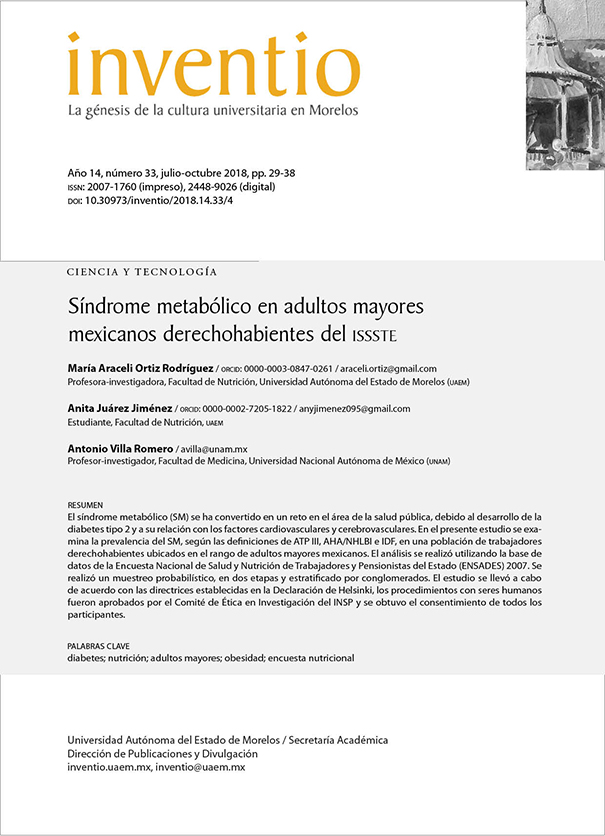Síndrome metabólico en adultos mayores derechohabientes del ISSSTE
Palabras clave:
diabetes, nutrición, adultos mayores, obesidad, encuesta nutricionalResumen
El síndrome metabólico (SM) se ha convertido en un reto en el área de la salud pública, debido al desarrollo de la diabetes tipo 2 y a su relación con los factores cardiovasculares y cerebrovasculares. En el presente estudio se examina la prevalencia del SM, según las definiciones de ATP III, AHA/NHLBI e IDF, en una población de trabajadores derechohabientes ubicados en el rango de adultos mayores mexicanos. El análisis se realizó utilizando la base de datos de la Encuesta Nacional de Salud y Nutrición de Trabajadores y Pensionistas del Estado (ENSADES) 2007. Se realizó un muestreo probabilístico, en dos etapas y estratificado por conglomerados. El estudio se llevó a cabo de acuerdo con las directrices establecidas en la Declaración de Helsinki, los procedimientos con seres humanos fueron aprobados por el Comité de Ética en Investigación del INSP y se obtuvo el consentimiento de todos los participantes.
Citas
Alberti, K. Zimmet, P., Shaw, J. e IDF Epidemiology Task Force Consensus Group, “The metabolic syndrome: a new worldwide definition”, The Lancet, vol. 366, 2005, pp. 1059-1062, DOI: 10.1016/S0140-6736(05)67402-8
Aschner, P. Concepto y epidemiología del síndrome metabólico, cap. 1, ALAD, Barcelona, 2003.
Cornier, M., Dabelea, D., Hernandez, T., Lindstrom, R.c., Steig, A., Stob, N., Van Pelt, R. Wang, H. Y Eckel, R. “The metabolic syndrome”,
Endocrine Reviews, 2008, vol. 29, núm. 7, 2008, pp. 777-822, DOI: 10.1210/er.2008-0024
DeSantis, C., Jemal, A. y Ward, E. “Disparities in breast cáncer prognostic factos by race, insurance status, and education”, Cancer Causes & Control, vol. 21, núm. 9, 2010, pp. 1445-1450, DOI: 10.1007/s10552-010-9572-z
Encuesta Nacional de Salud y Nutrición del Derechohabiente del Instituto de Seguridad y Servicios Sociales para los Trabajadores del Estado (ENSADER) 2007, INSP, Cuernavaca, 2007, https://bit.ly/2yyrpRE
Executive summary of the Third Report of the National Cholesterol Education Program (NCEP), Expert Panel on Detection, Evaluation and Treatment of High Blood Cholesterol in Adults (Adult Treatment Panel III), JAMA 2001, vol. 285, núm. 19, pp. 2486-2497, https://bit.ly/2PPg9qF
Friedewald, W., Levy, R. y Fredrickson, D. “Estimation of the concentration of low-density lipoprotein cholesterol in plasma: without use of the preparative ultracentrifuge”, Clinical Chemistry, vol. 18, núm. 6, 1972, pp. 499-502, https://bit.ly/2JdiJ7s
Gupta, R., Kaul, V., Agrawal, A., Guptha, S., Gupta, V.P. “Cardiovascular risk according to educational status in India”, Preventive Medicine, vol. 51, núm. 5, 2010, pp. 408-411, DOI: 10.1016/j.ypmed.2010.08.014
Gutiérrez, J., Rivera-Dommarco, J., Shamah-Levy, T., Villalpando-
Hernández, S., Franco, A., Cuevas-Nasu, L. Romero-Martínez, M. y Hernández-Ávila, M. (coordinadores), Encuesta Nacional de Salud y Nutrición (ENSANUT) 2012. Resultados Nacionales, INSP, Cuernavaca, 2012, https://bit.ly/2HSEXy4
Grover, S., Malhotra, N., Chakrabarti, S. Y Kulhara, P. “Metabolic syndrome in bipolar disorders”, Indian Journal of Psychological Medicine, vol. 34, núm. 2, abril-junio de 2012, pp. 110-118, DOI: 10.4103/0253-7176.101767
Grundy, S. Cleeman, J.I., Daniels, S.R., Donato, K.A. Eckel, H., Franklin, A., Gordon, D., Krauss, R., Savage, P.J., Smith, S., Sperus, A., Costa, F. y Nhlbi, A. “Diagnosis and management of the metabolic syndrome. An American Heart Association/National Heart, Lung, and Blood Institute Scientific Statement”, Circulation, vol. 112, núm. 17, 2005, pp. 2735-2752, DOI: 10.1161/circulationaha.105.169404
Icli, F., Akbulut, H., Yalcin, B., Ozdemir, F., Isikdogan, A., Hayran, M., Unsal, D., Coskun, S., Buyukcelik, A. y Yamac, D. “Education, economic status and other risk factors in gastric cancer: ‘a case-control study of Turkish Oncology Group’”, Medical Oncology, vol. 28, núm. 1, 2011, pp. 112-120, DOI: 10.1007/s12032-009-9406-6
James, W.P. “The epidemiology of obesity: the size of the problema”, Journal of Internal Medicine, vol. 263, núm. 4, 2008, pp. 336-352, DOI: 10.1111/j.1365-2796.2008.01922.x
Kurzinger, M., Pagnier, J., Kahn, J., Hampshire, R., Wakabi, T., y Tinte, T. “Education status among orphans and non-orphans in communities affected by AIDS in Tanzania and Burkina Faso”, AIDS Care, vol. 20, núm. 6, 2008, pp. 726-732, DOI: 10.1080/09540120701693958
Loucks, E., Rehkopf, D., Thurston, R. y Kawachi, I. “Socioeconomic disparities in metabolic syndrome differ by gender: evidence from NHANES III”, Annals of Epidemiology, vol. 17, núm. 1, 2007, pp. 19-26, DOI: 10.1016/j.annepidem.2006.07.002
Low, S., Chin, C. Y Deurenberg-Yap, M. “Review on epidemic of obesity”, Annals of the Academy of Medicine Singapore, vol. 38, núm. 1, 2009, pp. 57-59, https://bit.ly/2z0mI2x
Misra, A. y Khurana, L. “Obesity and the metabolic syndrome in developing countries”, The Journal of Clinical Endocrinology and Metabolism, vol. 93, núm. 11, Suppl. 1, 2008, pp. S9-30, DOI: 10.1210/jc.2008-1595
Murguía-Romero, M., Jiménez-Flores, R., Villalobos-Molina, R. y Méndez-Cruz, A. “Estimating the geographical distribution of the prevalence of the metabolic syndrome in young mexicans”, Geospatial Health, vol. 6, núm. 3, 2012, pp. S43-50, DOI: 10.4081/gh.2012.121
Olaiz-Fernández, G., Rivera-Dommarco, J., Shamah-Levy, T., Rojas, R., Villalpando-Hernández, S., Hernández-Ávila, M. y Sepúlveda-Amor, J. Encuesta Nacional de Salud y Nutrición (ENSANUT) 2006, INSP, Cuernavaca, 2006, https://bit.ly/2q8P7zn
Programa Institucional 2007-2012, ISSSTE, Ciudad de México, 2008, https://bit.ly/2CAK4zh
Stefan, N., Kantartzis, K., Machann, J., Schick, F., Thamer, C., Ritting, K., Balletshofer, B., Machicao, F., Fritsche, A. y Haring, H.U. “Identification and characterization of metabolically benign obesity in humans”, Archives of Internal Medicine, vol. 168, núm. 15, 2008, pp. 1609-1616, DOI: 10.1001/archinte.168.15.1609
Wang, Y. Colditz, G. Y Kuntz, K. “Forecasting the obesity epidemic in the aging U.S. population”, Obesity (Silver Spring), vol. 15, núm. 11, 2007, pp. 2855-65, DOI: 10.1038/oby.2007.339
Wildman, R.P., Muntner, P., Reynolds, K., McGinn, A., Rajpathak, S., Wylie-Rosett, J. y Sowers, M. “The obese without cardiometabolic risk factor clustering and the normal weight with cardiometabolic risk factor clustering: prevalence and correlates of 2 phenotypes among the US population (nhanes 1999-2004)”, Archives of Internal Medicine, vol. 168, núm. 15, 2008, pp. 1617-24, DOI: 10.1001/archinte.168.15.1617

Publicado
Cómo citar
Número
Sección
Licencia

Esta obra está bajo una licencia internacional Creative Commons Atribución-NoComercial 4.0.
Esta revista proporciona acceso abierto inmediato a su contenido, con base en el principio de ofrecer al público un acceso libre a las investigaciones para contribuir a un mayor intercambio global de conocimientos. Se distribuye bajo una licencia Creative Commons Reconocimiento-NoComercial 4.0 Internacional License.

